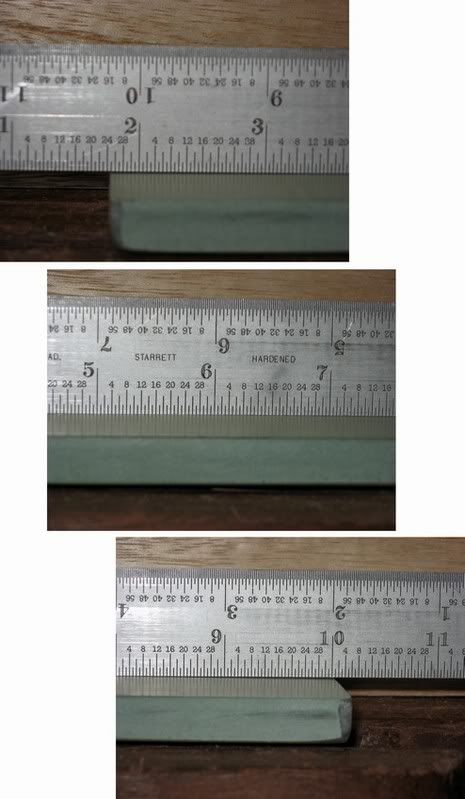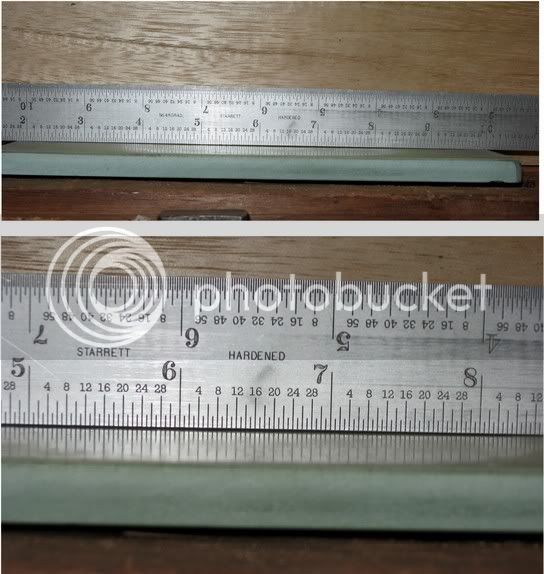Derek Cohen (Perth Oz)
Established Member
I recently bought two Shapton Professional waterstones, a 5000 and a 8000 on eBay. The 5000 is 80% thickness (12 of 15mm), and the 8000 is 60% thickness (9 of 15mm). Overall they cost me about half the new price, and this was important because (along with the 1000 I bought new), this is a very expensive system to purchase (compared to my 800/1200/8000 King waterstones), all up over $200 USD new.
It is relevant to note that the reason for purchase is that I want a cleaner, less demanding system. The Shaptons are noted for minimal water use and for remaining flat a long time.
Shortly after winning and paying for the stones, I was brousing the forums for more info about Shapton and came across a post from the Seller discussing these very stones. In the post he was complaining that he could not stop the 8000 stone from flexing. He would use it, then flatten it, then leave it to dry out. Later he would find that the stone had flexed about 1mm and was no longer flat.
His stones wound up on eBay, and I bought then because none of this was made evident. I emailed him even before I received the stones in the mail, and this is his reply:
All stones need to be flattened before and during use. Many man made synthetic stones move when going from wet to dry back to wet again. Humidity etc.... Naniwa is another. Shaptons will move a little some more than others.
Now I think that this is nonsense. Yes, all waterstones need to be flattened, but "move a little more"? Move at all!!
The stones duly arrived (very well packed, I might add), and I examined them carefully. Using a Starrett square I found the working side of the 5000 perfectly flat. However the 8000 was convex by about 1mm at each end and on the reverse it was concave in the centre by about 2mm. This indicates a "banana" shape to the 8000, and tends to reinforce the early complaints of the stone moving and flexing.
It occurred to me that the reason why there was a difference in the thicknesses of the 5000 and 8000 was that the Seller had flatened the latter so many more times to make it usable (he had also sold a 2000 Shapton - which I did not bid on - and this was the same thickness as the 5000. So the 8000 was the odd one out).
I emailed the Seller about this two days ago saying that I want to return the 8000 stone and be refunded my expenses (at least for the cost of the stone plus half the shipping cost - plus more for shipping it back?). He has not replied and I fear that he will not do so. Two days to respond is enough time I think, but I will email him again and give him until the end of the weekend.
One thing I have had reinforced is "cheap is dear". If I can get a refund, I will pay the full price for a new 8000 stone (as an aside, is it worth/possible going from a 5000 to a 12000?).
Another issue is whether any others have experienced this phenomena with their Shaptons, especially as they wear and get thinner? I just cannot see how they would/could sell them if that reacted this way. Shapton would go out of business.
Now one last question. On the assumption that the Seller will not come to the party and I am left with this flexing stone, I could just try and "fix" it. This would involve epoxying the stone to a sheet of glass. I would use a 4-6mm thick piece of float glass the same dimension as the stone so that it can be replaced within its plastic box. The advantage of this is that it will essentially return the stone to full thickness and allow it to be used to the end (I wonder how far one could otherwise go - with my Kings I have gone as far as a 1/8" - 3mm - before replacement).
My question with the use of two-part epoxy is in regard to the effect on the waterstone. Gluing it to glass should be straightforward, but will the now (I hope) absence of flex cause stresses in the stone and cause it to crack? This is quite critical since I would be prepared to negotiate a lower price with the Seller (for cost of additional materials) and keep the stone if this repair it doable.
Last point here - I would plan to epoxy the convex working side face down since it would be very difficult to remove the convex. It is easier to flatten a concave side. This all assumes that the stones are usable all the way through. I assume that they are. Can someone confirm this for me plaese.
I await all comments. Thanks in advance.
Regards from Perth
Derek
It is relevant to note that the reason for purchase is that I want a cleaner, less demanding system. The Shaptons are noted for minimal water use and for remaining flat a long time.
Shortly after winning and paying for the stones, I was brousing the forums for more info about Shapton and came across a post from the Seller discussing these very stones. In the post he was complaining that he could not stop the 8000 stone from flexing. He would use it, then flatten it, then leave it to dry out. Later he would find that the stone had flexed about 1mm and was no longer flat.
His stones wound up on eBay, and I bought then because none of this was made evident. I emailed him even before I received the stones in the mail, and this is his reply:
All stones need to be flattened before and during use. Many man made synthetic stones move when going from wet to dry back to wet again. Humidity etc.... Naniwa is another. Shaptons will move a little some more than others.
Now I think that this is nonsense. Yes, all waterstones need to be flattened, but "move a little more"? Move at all!!
The stones duly arrived (very well packed, I might add), and I examined them carefully. Using a Starrett square I found the working side of the 5000 perfectly flat. However the 8000 was convex by about 1mm at each end and on the reverse it was concave in the centre by about 2mm. This indicates a "banana" shape to the 8000, and tends to reinforce the early complaints of the stone moving and flexing.
It occurred to me that the reason why there was a difference in the thicknesses of the 5000 and 8000 was that the Seller had flatened the latter so many more times to make it usable (he had also sold a 2000 Shapton - which I did not bid on - and this was the same thickness as the 5000. So the 8000 was the odd one out).
I emailed the Seller about this two days ago saying that I want to return the 8000 stone and be refunded my expenses (at least for the cost of the stone plus half the shipping cost - plus more for shipping it back?). He has not replied and I fear that he will not do so. Two days to respond is enough time I think, but I will email him again and give him until the end of the weekend.
One thing I have had reinforced is "cheap is dear". If I can get a refund, I will pay the full price for a new 8000 stone (as an aside, is it worth/possible going from a 5000 to a 12000?).
Another issue is whether any others have experienced this phenomena with their Shaptons, especially as they wear and get thinner? I just cannot see how they would/could sell them if that reacted this way. Shapton would go out of business.
Now one last question. On the assumption that the Seller will not come to the party and I am left with this flexing stone, I could just try and "fix" it. This would involve epoxying the stone to a sheet of glass. I would use a 4-6mm thick piece of float glass the same dimension as the stone so that it can be replaced within its plastic box. The advantage of this is that it will essentially return the stone to full thickness and allow it to be used to the end (I wonder how far one could otherwise go - with my Kings I have gone as far as a 1/8" - 3mm - before replacement).
My question with the use of two-part epoxy is in regard to the effect on the waterstone. Gluing it to glass should be straightforward, but will the now (I hope) absence of flex cause stresses in the stone and cause it to crack? This is quite critical since I would be prepared to negotiate a lower price with the Seller (for cost of additional materials) and keep the stone if this repair it doable.
Last point here - I would plan to epoxy the convex working side face down since it would be very difficult to remove the convex. It is easier to flatten a concave side. This all assumes that the stones are usable all the way through. I assume that they are. Can someone confirm this for me plaese.
I await all comments. Thanks in advance.
Regards from Perth
Derek



































